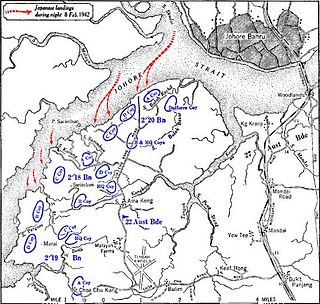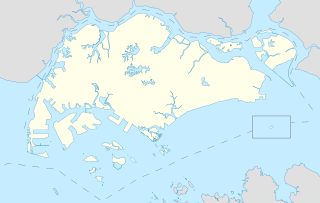 W
WThe Battle of Sarimbun Beach was the first stage of the Japanese assault on Singapore in February 1942 during World War II. Sarimbun Beach, located in the northwestern corner of mainland Singapore, was the area in which Japanese troops, under the overall direction of Lieutenant-General Tomoyuki Yamashita, first attacked Allied forces in Singapore. The overall commander of all Allied forces in Singapore, Lieutenant-General Arthur Percival, did not expect the Japanese to make their main attack on the island from the northwest and subsequently failed to reinforce the later-beleaguered Australian 22nd Brigade, which took the brunt of the Japanese assault. The main Japanese objective to be attained following their landing at Sarimbun Beach was the capture of Tengah Airfield.
 W
WThe Battle of Singapore, also known as the Fall of Singapore, was fought in the South-East Asian theatre of World War II when the Empire of Japan captured the British stronghold of Singapore—nicknamed the "Gibraltar of the East". Singapore was the major British military base in South-East Asia and was the key to British imperial interwar defence planning for South-East Asia and the South-West Pacific. The fighting in Singapore lasted from 8 to 15 February 1942. The Japanese victory was decisive, resulting in the Japanese capture of Singapore and the largest British surrender in history.
 W
WThe Battle of Bukit Timah, was part of the final stage of the Empire of Japan's invasion of Singapore during World War II.
 W
WMV Empire Star was a UK refrigerated cargo liner. She was built by Harland and Wolff in 1935 as one of Blue Star Line's Imperial Star-class ships, designed to ship frozen meat from Australia and New Zealand to the United Kingdom. She served in the Second World War and is distinguished for her role in the Evacuation of Singapore in February 1942. She was sunk by torpedo in October 1942 with the loss of 42 lives.
 W
WThe Kempeitai East District Branch was the headquarters of the Kempeitai, the Japanese military police, during the Japanese occupation of Singapore from 1942 to 1945. It was located at the old YMCA building, at the present site of Singapore's YMCA Building on Stamford Road. Opened in 1911, the distinctive Art Deco YMCA building was the site of interrogation and torture of many innocent civilians, including the war heroine Elizabeth Choy. After the war, the Singapore government erected several memorials with some at the former massacre sites. In 1995, the former site of the old YMCA building was gazetted by the National Heritage Board as one of the eleven World War II sites of Singapore.
 W
WThe Kenpeitai West District Branch was one of the branches of the Kenpeitai in Singapore besides the much noted Kenpeitai East District Branch during the Japanese occupation of Singapore from 1942 to 1945.
 W
WThe Battle of Kranji was the second stage of the Empire of Japan's plan for the invasion of Singapore during the Second World War. On 9 February 1942 the Imperial Japanese Army assaulted the north-western front of the British colony of Singapore. Their primary objective was to secure a second beachhead after their successful assault at Sarimbun Beach on 8 February, in order to breach the Jurong-Kranji defence line as part of their southward thrust towards the heart of Singapore City. Defending the shoreline between the Kranji River and the Johor–Singapore Causeway was the Australian 27th Brigade, led by Brigadier Duncan Maxwell, and one irregular company. On 10 February the Japanese forces suffered their heaviest losses while moving up the Kranji River, which caused them to panic and nearly aborted the operation. However, a series of miscommunications and withdrawals by Allied forces in the ensuing battles allowed the Japanese to swiftly gain strategic footholds, which eventually led to the fall of Singapore on 15 February 1942.
 W
WThe Battle of Pasir Panjang, which took place between 12 and 15 February 1942, was part of the final stage of the Empire of Japan's invasion of Singapore during World War II. The battle was initiated upon the advancement of elite Imperial Japanese Army forces towards Pasir Panjang Ridge on 13 February.
 W
WThe Selarang Barracks incident, also known as the Barrack Square incident or the Selarang Square Squeeze, was a revolt of British and Australian prisoners-of-war (POWs) interned in a Japanese camp in Changi, Singapore.
 W
WThe Sook Ching was a systematic purge of perceived hostile elements among the Chinese Malayans and the Chinese in Singapore by the Japanese military during the Japanese occupation of Singapore and Malaya, after the British colony surrendered on 15 February 1942 following the Battle of Singapore. The purge took place from 18 February to 4 March 1942 at various places in the region. The operation was overseen by the Imperial Japanese Army's Kempeitai secret police and subsequently extended to include the Chinese population in Malaya.